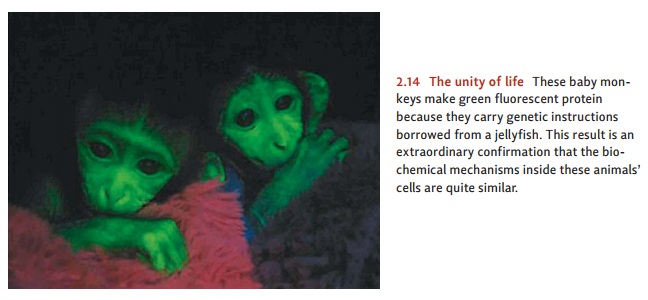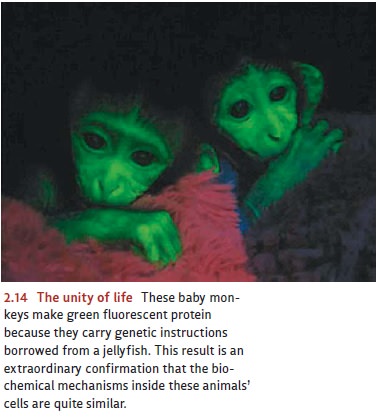Chapter: Psychology: The Genetic and Evolutionary Roots of Behavior
The Unity of Life

The Unity of
Life
As we have seen, Charles Darwin
deserves credit for two great ideas. We’ve looked closely at his idea of
natural selection, the process that changes the traits of a popula-tion over
time and may eventually create entirely new species. His other idea concerns
the starting point for this
process—namely, that all modern organisms descended, with modifications over
time, from a common ancestor. Darwin was correct about this point as well—and
as we’ll see, this idea has important implications for psychology.
Evidence in support of this
shared ancestry comes from the many (and sometimes surprising) commonalities
among species. For example, close examination of the genomes of birds and crocodiles
tells us that they have an enormous amount in common—in fact, they’re
genetically more similar to each other than either of them is to any other
animal group (Janke, Erpenbeck, Nilsson, & Arnason, 2001). Birds and
crocodiles, therefore, are each other’s closest living relative; and this helps
us under-stand the various traits they share, such as building nests, laying
hard-shelled eggs, and caring for their young. Similar commonalities confirm
that the closest living relatives of the whales are the even-toed, hoofed
mammals, including the hippos (Geisler & Theodor, 2009; Thewissen, Cooper,
Clements, Bajpai, & Tiwari, 2009). Our own closest living relatives—a fact
evident in shared anatomy, shared behaviors, and very similar genomes—are the
common chimpanzee and the bonobo.
In fact, this sharing of
attributes extends quite a long way—because ultimately, all of Earth’s living things are derived from a common lineage.
This extraordinary unity of life is evident in some remarkable similarities
among our planet’s creatures. Here’s a demonstration: Crystal jellyfish have a
gene enabling them to make a substance

called green fluorescent protein,
and this protein makes the jellyfish glow green in the blue light of the ocean.
Genetic engineers recently took a copy of the jellyfish’s gene and inserted it
into the chromo-somes of rhesus monkey egg cells (Yang et al., 2008). The
scientists fertilized the egg cells in a dish and then implanted them in a sur-rogate
mother monkey. The mother gave birth to baby monkeys that make green
fluorescent protein—and so, under blue light, the mon-keys emit a bright green
glow (Figure 2.14).
Genes transferred between species
can not only grant novel functions, they can also restore functions lost as a
result of genetic defects. Fruit flies have a gene called apterous that plays a variety of crucial roles in the development
of the adult fly. Flies that lack func-tional copies of this gene have, among
other defects, no wings. However, when given the human version of the gene (called hLhx2), the flies develop normally (Rincón-Limas, Lu, Canal,
Calleja, Rodríguez-Esteban, et al., 1999).
These results provide powerful
evidence that diverse species are indeed descended from common ancestors. After
all, the fact that a jellyfish gene works just fine inside the cells of a
monkey indicates that monkeys and jellyfish are related. Likewise, the fact
that a human gene can substitute for one in the fruit fly shows that humans and
flies are kin.
The unity of life is essential to
psychology. Because of our shared ancestors, we have much in common with other
species; and this is why we can learn a great deal about us by studying them.
Thus, we can gain an understanding of human memory by studying learning in sea
snails; we can learn about the genetic roots of ADHD through studies that
involve genetic engineering in mice; and we can develop new medications for mental
illness by studying the effect of these pills on laboratory rats. All of these
advances rest on the strong biological resemblance between humans and other
animals, which is a result of our common ancestry.
Related Topics